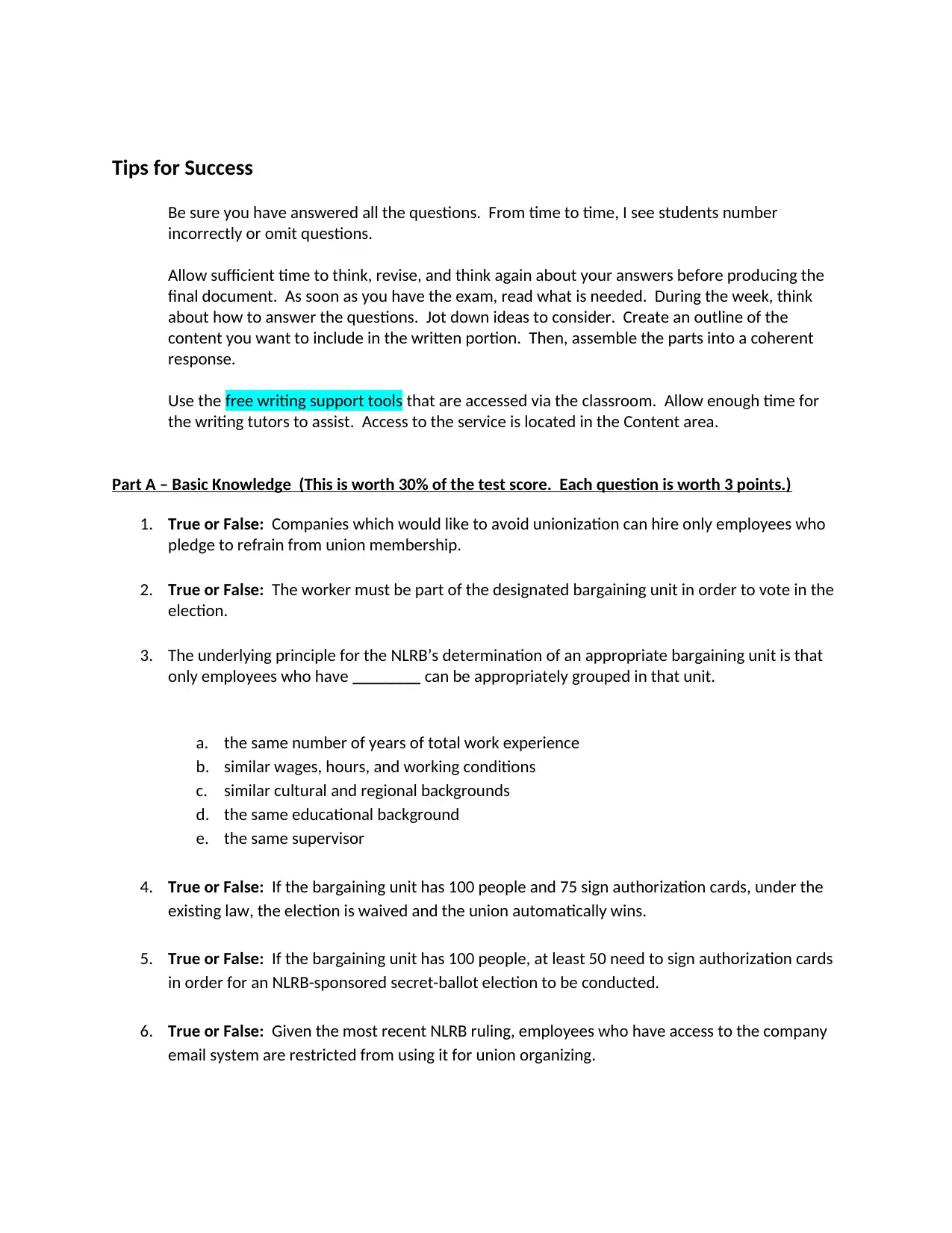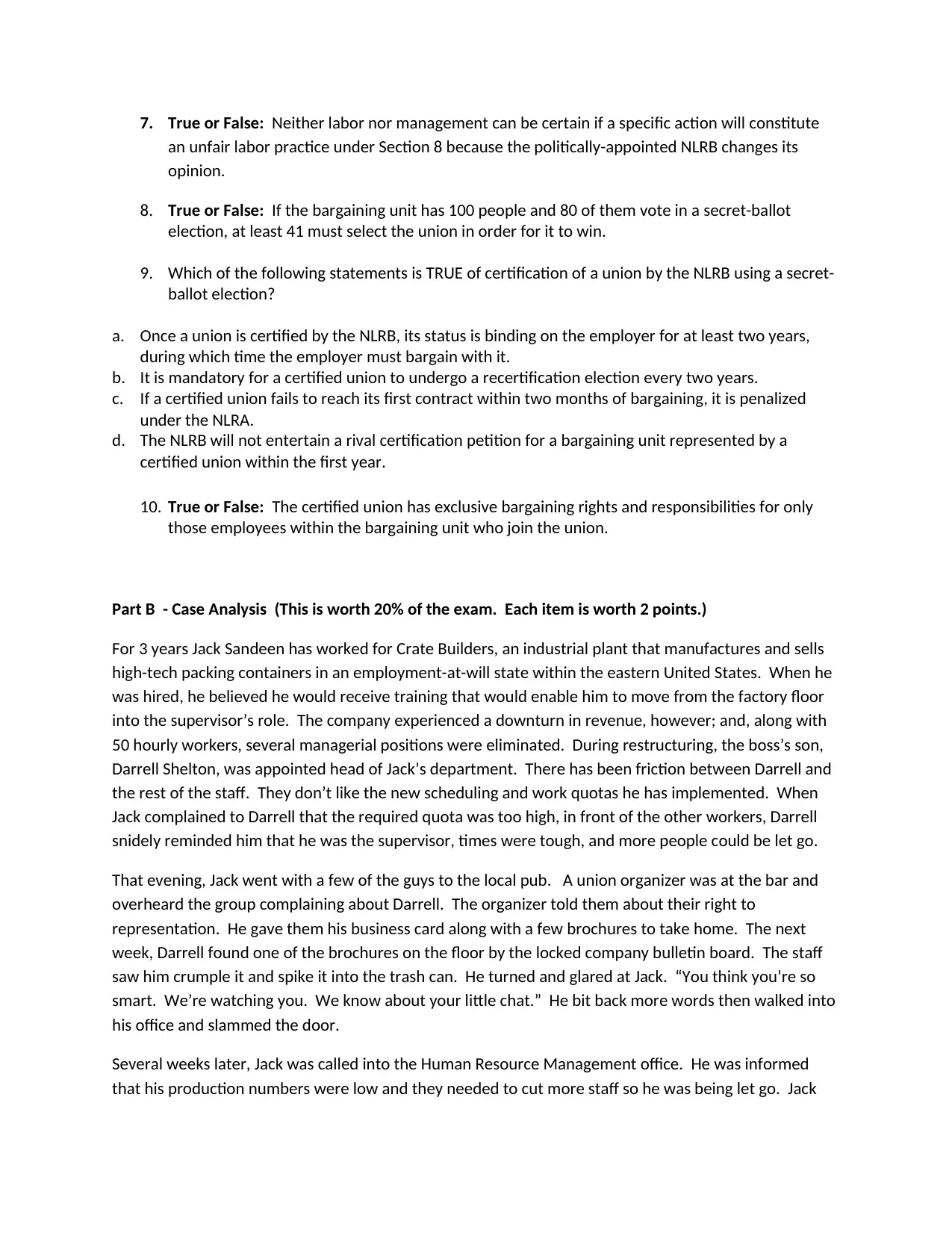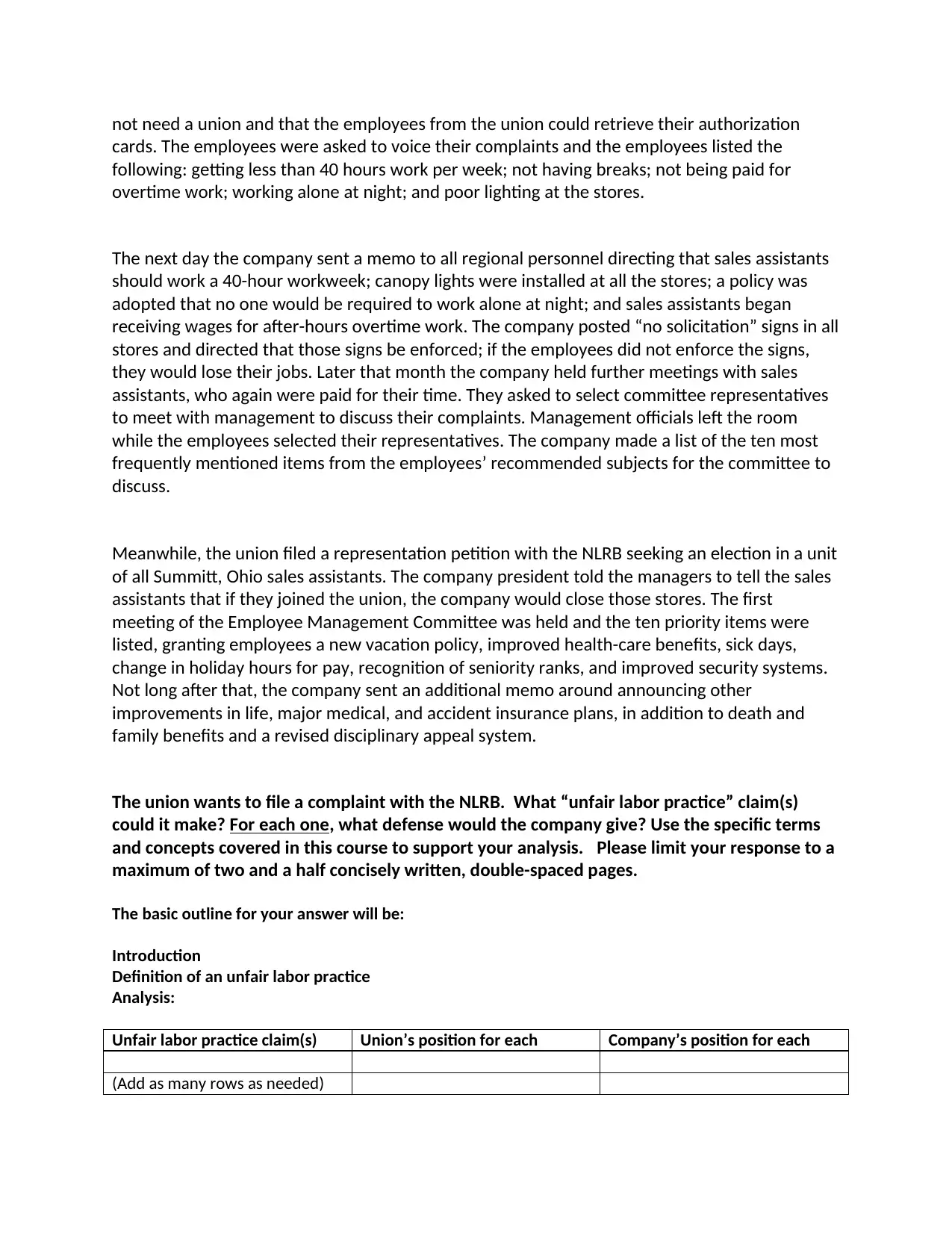Representation and Unfair Labor Practices
VerifiedAdded on 2019/09/26
|5
|1998
|195
Essay
AI Summary
A summary of this case is as follows: Jack, an employee, was fired after reporting a union organizing effort. His production numbers were low, but there was no evidence to suggest he was being targeted for his participation in the union. The company's decision to terminate him may be seen as retaliatory and potentially violate labor laws. The case highlights the importance of ensuring fair treatment and promoting open communication within the workplace.
Contribute Materials
Your contribution can guide someone’s learning journey. Share your
documents today.

Tips for Success
Be sure you have answered all the questions. From time to time, I see students number
incorrectly or omit questions.
Allow sufficient time to think, revise, and think again about your answers before producing the
final document. As soon as you have the exam, read what is needed. During the week, think
about how to answer the questions. Jot down ideas to consider. Create an outline of the
content you want to include in the written portion. Then, assemble the parts into a coherent
response.
Use the free writing support tools that are accessed via the classroom. Allow enough time for
the writing tutors to assist. Access to the service is located in the Content area.
Part A – Basic Knowledge (This is worth 30% of the test score. Each question is worth 3 points.)
1. True or False: Companies which would like to avoid unionization can hire only employees who
pledge to refrain from union membership.
2. True or False: The worker must be part of the designated bargaining unit in order to vote in the
election.
3. The underlying principle for the NLRB’s determination of an appropriate bargaining unit is that
only employees who have ________ can be appropriately grouped in that unit.
a. the same number of years of total work experience
b. similar wages, hours, and working conditions
c. similar cultural and regional backgrounds
d. the same educational background
e. the same supervisor
4. True or False: If the bargaining unit has 100 people and 75 sign authorization cards, under the
existing law, the election is waived and the union automatically wins.
5. True or False: If the bargaining unit has 100 people, at least 50 need to sign authorization cards
in order for an NLRB-sponsored secret-ballot election to be conducted.
6. True or False: Given the most recent NLRB ruling, employees who have access to the company
email system are restricted from using it for union organizing.
Be sure you have answered all the questions. From time to time, I see students number
incorrectly or omit questions.
Allow sufficient time to think, revise, and think again about your answers before producing the
final document. As soon as you have the exam, read what is needed. During the week, think
about how to answer the questions. Jot down ideas to consider. Create an outline of the
content you want to include in the written portion. Then, assemble the parts into a coherent
response.
Use the free writing support tools that are accessed via the classroom. Allow enough time for
the writing tutors to assist. Access to the service is located in the Content area.
Part A – Basic Knowledge (This is worth 30% of the test score. Each question is worth 3 points.)
1. True or False: Companies which would like to avoid unionization can hire only employees who
pledge to refrain from union membership.
2. True or False: The worker must be part of the designated bargaining unit in order to vote in the
election.
3. The underlying principle for the NLRB’s determination of an appropriate bargaining unit is that
only employees who have ________ can be appropriately grouped in that unit.
a. the same number of years of total work experience
b. similar wages, hours, and working conditions
c. similar cultural and regional backgrounds
d. the same educational background
e. the same supervisor
4. True or False: If the bargaining unit has 100 people and 75 sign authorization cards, under the
existing law, the election is waived and the union automatically wins.
5. True or False: If the bargaining unit has 100 people, at least 50 need to sign authorization cards
in order for an NLRB-sponsored secret-ballot election to be conducted.
6. True or False: Given the most recent NLRB ruling, employees who have access to the company
email system are restricted from using it for union organizing.
Secure Best Marks with AI Grader
Need help grading? Try our AI Grader for instant feedback on your assignments.

7. True or False: Neither labor nor management can be certain if a specific action will constitute
an unfair labor practice under Section 8 because the politically-appointed NLRB changes its
opinion.
8. True or False: If the bargaining unit has 100 people and 80 of them vote in a secret-ballot
election, at least 41 must select the union in order for it to win.
9. Which of the following statements is TRUE of certification of a union by the NLRB using a secret-
ballot election?
a. Once a union is certified by the NLRB, its status is binding on the employer for at least two years,
during which time the employer must bargain with it.
b. It is mandatory for a certified union to undergo a recertification election every two years.
c. If a certified union fails to reach its first contract within two months of bargaining, it is penalized
under the NLRA.
d. The NLRB will not entertain a rival certification petition for a bargaining unit represented by a
certified union within the first year.
10. True or False: The certified union has exclusive bargaining rights and responsibilities for only
those employees within the bargaining unit who join the union.
Part B - Case Analysis (This is worth 20% of the exam. Each item is worth 2 points.)
For 3 years Jack Sandeen has worked for Crate Builders, an industrial plant that manufactures and sells
high-tech packing containers in an employment-at-will state within the eastern United States. When he
was hired, he believed he would receive training that would enable him to move from the factory floor
into the supervisor’s role. The company experienced a downturn in revenue, however; and, along with
50 hourly workers, several managerial positions were eliminated. During restructuring, the boss’s son,
Darrell Shelton, was appointed head of Jack’s department. There has been friction between Darrell and
the rest of the staff. They don’t like the new scheduling and work quotas he has implemented. When
Jack complained to Darrell that the required quota was too high, in front of the other workers, Darrell
snidely reminded him that he was the supervisor, times were tough, and more people could be let go.
That evening, Jack went with a few of the guys to the local pub. A union organizer was at the bar and
overheard the group complaining about Darrell. The organizer told them about their right to
representation. He gave them his business card along with a few brochures to take home. The next
week, Darrell found one of the brochures on the floor by the locked company bulletin board. The staff
saw him crumple it and spike it into the trash can. He turned and glared at Jack. “You think you’re so
smart. We’re watching you. We know about your little chat.” He bit back more words then walked into
his office and slammed the door.
Several weeks later, Jack was called into the Human Resource Management office. He was informed
that his production numbers were low and they needed to cut more staff so he was being let go. Jack
an unfair labor practice under Section 8 because the politically-appointed NLRB changes its
opinion.
8. True or False: If the bargaining unit has 100 people and 80 of them vote in a secret-ballot
election, at least 41 must select the union in order for it to win.
9. Which of the following statements is TRUE of certification of a union by the NLRB using a secret-
ballot election?
a. Once a union is certified by the NLRB, its status is binding on the employer for at least two years,
during which time the employer must bargain with it.
b. It is mandatory for a certified union to undergo a recertification election every two years.
c. If a certified union fails to reach its first contract within two months of bargaining, it is penalized
under the NLRA.
d. The NLRB will not entertain a rival certification petition for a bargaining unit represented by a
certified union within the first year.
10. True or False: The certified union has exclusive bargaining rights and responsibilities for only
those employees within the bargaining unit who join the union.
Part B - Case Analysis (This is worth 20% of the exam. Each item is worth 2 points.)
For 3 years Jack Sandeen has worked for Crate Builders, an industrial plant that manufactures and sells
high-tech packing containers in an employment-at-will state within the eastern United States. When he
was hired, he believed he would receive training that would enable him to move from the factory floor
into the supervisor’s role. The company experienced a downturn in revenue, however; and, along with
50 hourly workers, several managerial positions were eliminated. During restructuring, the boss’s son,
Darrell Shelton, was appointed head of Jack’s department. There has been friction between Darrell and
the rest of the staff. They don’t like the new scheduling and work quotas he has implemented. When
Jack complained to Darrell that the required quota was too high, in front of the other workers, Darrell
snidely reminded him that he was the supervisor, times were tough, and more people could be let go.
That evening, Jack went with a few of the guys to the local pub. A union organizer was at the bar and
overheard the group complaining about Darrell. The organizer told them about their right to
representation. He gave them his business card along with a few brochures to take home. The next
week, Darrell found one of the brochures on the floor by the locked company bulletin board. The staff
saw him crumple it and spike it into the trash can. He turned and glared at Jack. “You think you’re so
smart. We’re watching you. We know about your little chat.” He bit back more words then walked into
his office and slammed the door.
Several weeks later, Jack was called into the Human Resource Management office. He was informed
that his production numbers were low and they needed to cut more staff so he was being let go. Jack

asked to see the statistics for the department, but HR said that was proprietary information. When he
asked who else was being fired, HR told him that was also private information. The guys at the bar told
Jack later that they could not find anyone else who was terminated when he was.
1. True or False: The comment “We know about your little chat” would help management in a
Wright Line test.
2. True or False: If Jack’s production numbers were higher than most, this data would support
management in a Wright Line test.
3. True or False: Since this is an employment-at-will state and there is no union in place,
management can legally terminate Jack without considering any Wright Line test results.
4. True or False: At work, Jack had a right to solicit other employees in his department to join the
union as long as he did it during regular working hours and didn’t do it in front of customers.
5. True or False: The union would see the comment “We’re watching you” as an unfair labor
practice under Section 8(a)1 of the NLRA.
6. True or False: Promoting Jack to supervisor in the last restructuring would have been a legal
way to avoid his union participation.
7. True or False: The company can terminate a supervisor at any time for any reason if it does not
have other policies or contracts that contradict that flexibility.
8. True or False: Terminating others who were not involved with the union at the same time Jack
was let go would support the company’s position in an unfair labor practice charge.
9. True or False: Section 7 rights require the company to terminate those with less than the 3
years seniority Jack has before letting him go.
10. True or False: Darrell’s comments represent Budd’s concept of voice.
Part C – Case Analysis - (This is worth 50% of the test score.)
The company operates about 700 convenience stores. A sales assistant at one of the company’s
stores was murdered while on duty. The murder was widely publicized, and employees
complained of inadequate security measures. As a result of the murder, 15 sales assistants
telephoned the union requesting a union organization effort. The union sent representatives to
60 stores in the area where the murder had occurred and left union authorization cards. Two
days later the company notified the union that an injunction had been issued during a prior
union campaign prohibiting solicitation on company property.
The next workday, the company had a meeting with the store managers in the area and talked
about the need to improve security. The company officials also discussed the union’s
organization activities and reminded the managers of the “no solicitation” policy and stated
that a union would not necessarily do the employees any good. Later that week, the company
had an unprecedented meeting for all sales assistants. Approximately 200 sales assistants
attended and were paid for their time. The company officials told the employees that they did
asked who else was being fired, HR told him that was also private information. The guys at the bar told
Jack later that they could not find anyone else who was terminated when he was.
1. True or False: The comment “We know about your little chat” would help management in a
Wright Line test.
2. True or False: If Jack’s production numbers were higher than most, this data would support
management in a Wright Line test.
3. True or False: Since this is an employment-at-will state and there is no union in place,
management can legally terminate Jack without considering any Wright Line test results.
4. True or False: At work, Jack had a right to solicit other employees in his department to join the
union as long as he did it during regular working hours and didn’t do it in front of customers.
5. True or False: The union would see the comment “We’re watching you” as an unfair labor
practice under Section 8(a)1 of the NLRA.
6. True or False: Promoting Jack to supervisor in the last restructuring would have been a legal
way to avoid his union participation.
7. True or False: The company can terminate a supervisor at any time for any reason if it does not
have other policies or contracts that contradict that flexibility.
8. True or False: Terminating others who were not involved with the union at the same time Jack
was let go would support the company’s position in an unfair labor practice charge.
9. True or False: Section 7 rights require the company to terminate those with less than the 3
years seniority Jack has before letting him go.
10. True or False: Darrell’s comments represent Budd’s concept of voice.
Part C – Case Analysis - (This is worth 50% of the test score.)
The company operates about 700 convenience stores. A sales assistant at one of the company’s
stores was murdered while on duty. The murder was widely publicized, and employees
complained of inadequate security measures. As a result of the murder, 15 sales assistants
telephoned the union requesting a union organization effort. The union sent representatives to
60 stores in the area where the murder had occurred and left union authorization cards. Two
days later the company notified the union that an injunction had been issued during a prior
union campaign prohibiting solicitation on company property.
The next workday, the company had a meeting with the store managers in the area and talked
about the need to improve security. The company officials also discussed the union’s
organization activities and reminded the managers of the “no solicitation” policy and stated
that a union would not necessarily do the employees any good. Later that week, the company
had an unprecedented meeting for all sales assistants. Approximately 200 sales assistants
attended and were paid for their time. The company officials told the employees that they did

not need a union and that the employees from the union could retrieve their authorization
cards. The employees were asked to voice their complaints and the employees listed the
following: getting less than 40 hours work per week; not having breaks; not being paid for
overtime work; working alone at night; and poor lighting at the stores.
The next day the company sent a memo to all regional personnel directing that sales assistants
should work a 40-hour workweek; canopy lights were installed at all the stores; a policy was
adopted that no one would be required to work alone at night; and sales assistants began
receiving wages for after-hours overtime work. The company posted “no solicitation” signs in all
stores and directed that those signs be enforced; if the employees did not enforce the signs,
they would lose their jobs. Later that month the company held further meetings with sales
assistants, who again were paid for their time. They asked to select committee representatives
to meet with management to discuss their complaints. Management officials left the room
while the employees selected their representatives. The company made a list of the ten most
frequently mentioned items from the employees’ recommended subjects for the committee to
discuss.
Meanwhile, the union filed a representation petition with the NLRB seeking an election in a unit
of all Summitt, Ohio sales assistants. The company president told the managers to tell the sales
assistants that if they joined the union, the company would close those stores. The first
meeting of the Employee Management Committee was held and the ten priority items were
listed, granting employees a new vacation policy, improved health-care benefits, sick days,
change in holiday hours for pay, recognition of seniority ranks, and improved security systems.
Not long after that, the company sent an additional memo around announcing other
improvements in life, major medical, and accident insurance plans, in addition to death and
family benefits and a revised disciplinary appeal system.
The union wants to file a complaint with the NLRB. What “unfair labor practice” claim(s)
could it make? For each one, what defense would the company give? Use the specific terms
and concepts covered in this course to support your analysis. Please limit your response to a
maximum of two and a half concisely written, double-spaced pages.
The basic outline for your answer will be:
Introduction
Definition of an unfair labor practice
Analysis:
Unfair labor practice claim(s) Union’s position for each Company’s position for each
(Add as many rows as needed)
cards. The employees were asked to voice their complaints and the employees listed the
following: getting less than 40 hours work per week; not having breaks; not being paid for
overtime work; working alone at night; and poor lighting at the stores.
The next day the company sent a memo to all regional personnel directing that sales assistants
should work a 40-hour workweek; canopy lights were installed at all the stores; a policy was
adopted that no one would be required to work alone at night; and sales assistants began
receiving wages for after-hours overtime work. The company posted “no solicitation” signs in all
stores and directed that those signs be enforced; if the employees did not enforce the signs,
they would lose their jobs. Later that month the company held further meetings with sales
assistants, who again were paid for their time. They asked to select committee representatives
to meet with management to discuss their complaints. Management officials left the room
while the employees selected their representatives. The company made a list of the ten most
frequently mentioned items from the employees’ recommended subjects for the committee to
discuss.
Meanwhile, the union filed a representation petition with the NLRB seeking an election in a unit
of all Summitt, Ohio sales assistants. The company president told the managers to tell the sales
assistants that if they joined the union, the company would close those stores. The first
meeting of the Employee Management Committee was held and the ten priority items were
listed, granting employees a new vacation policy, improved health-care benefits, sick days,
change in holiday hours for pay, recognition of seniority ranks, and improved security systems.
Not long after that, the company sent an additional memo around announcing other
improvements in life, major medical, and accident insurance plans, in addition to death and
family benefits and a revised disciplinary appeal system.
The union wants to file a complaint with the NLRB. What “unfair labor practice” claim(s)
could it make? For each one, what defense would the company give? Use the specific terms
and concepts covered in this course to support your analysis. Please limit your response to a
maximum of two and a half concisely written, double-spaced pages.
The basic outline for your answer will be:
Introduction
Definition of an unfair labor practice
Analysis:
Unfair labor practice claim(s) Union’s position for each Company’s position for each
(Add as many rows as needed)
Secure Best Marks with AI Grader
Need help grading? Try our AI Grader for instant feedback on your assignments.

Summary
Reference(s)
NOTE: Please re-read the instructions to be sure you’ve done everything that is needed.
Reference(s)
NOTE: Please re-read the instructions to be sure you’ve done everything that is needed.
1 out of 5
Your All-in-One AI-Powered Toolkit for Academic Success.
+13062052269
info@desklib.com
Available 24*7 on WhatsApp / Email
![[object Object]](/_next/static/media/star-bottom.7253800d.svg)
Unlock your academic potential
© 2024 | Zucol Services PVT LTD | All rights reserved.


